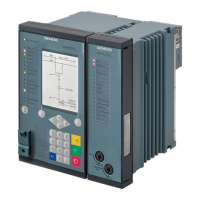The following table shows the result of the switching-authority check, based on the set switching authority
and the cause of the command. This overview represents a simplified normal case (no multiple command
sources when using Station and Remote).
Table 6-20 Result of a Switching-Authority Check
Cause Source Switching Authority
Local DIGSI Station Remote
Local Release Blocked Blocked Blocked
Station Blocked Blocked Release Blocked
Remote Blocked Blocked Blocked Release
Local automatic
operation
Release Release Release Release
Station automatic
operation
Blocked Blocked Release Blocked
Remote automatic
operation
Blocked Blocked Blocked Release
DIGSI Blocked Release Blocked Blocked
Specific Switching Authority
Special switching authorities can be configured as extension of the switching-authority check. This makes it
possible to differentiate the Remote command sources at the bay level. Switching authority can be routed to
or revoked from different control centers that can, for example, belong to different companies. Thus, precisely
one of these command sources can switch at a certain time. This function is based on extending the
switching-authority check by verifying the identifier of the command source (field Originator/orIdent of
switching command). In order to turn on the function, go to General/Control and set the check mark for the
parameter Specific sw. authorities. More settings for the configuration of the identifiers and the
behavior of the function as well as additional signals appear (see Figure 6-33). In order to permit an additional
command source to switch, you must activate this specific switching authority. In order to do this, set the
controllable Enable sw. auth. 1 to Enable sw. auth. 5.
Control Functions
6.3 Control Functionality
SIPROTEC 5, High-Voltage Bay Controller, Manual 341
C53000-G5040-C015-9, Edition 11.2017

